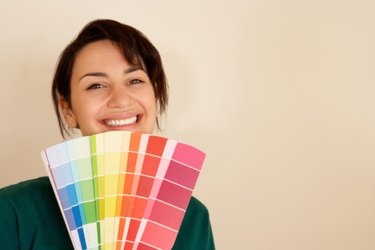
Color is an essential part of a room design. It is the primary factor that determines the feel of the space, and may have psychological and physical effects. When a room has low-light, color selection may become especially important. A low-light room will benefit greatly from a light shade of paint. These tones make rooms feel larger and reflect light better than dark colors, making them ideal for low-light spaces.
White
Video of the Day
Tones of white, including pure white, cream and eggshell, are among the most widely used in modern style decor. They promote a clean, open feel and will work with just about any furnishings, flooring and accents in the home. These tones, particularly when used in an eggshell or satin finish, reflect even small amounts of light, which creates a brighter, more open feel. These colors, if used on all four walls, may become overwhelming. Too much white may cause headaches, so an alternative cream or beige may be preferable.
Video of the Day
Warm Colors
Warm colors -- shades of red, orange and yellow -- are excellent at spicing up a room. When opting for a color from this family, tone is going to be especially important. Deeper tones are going to be more difficult to pull off in a low-light room, so instead opt for something a bit brighter. Not only will these colors add visual interest, but they are also more cheerful than plain white. Red is a bright, cheerful option that may be complemented with green, beige, brown or white. Orange provides a number of shades; some are pleasant and visually appealing, while others may be overwhelming. Pumpkin orange may be too much for a whole room; alternatives are copper for a sophisticated feel, or peach for better light reflection. Yellow should be selected carefully. Though most shades reflect light well, a too-bright shade may be overwhelming and hard on the eyes. Pastel yellow, according to color psychology, promotes a sunny atmosphere that encourages energy and enthusiasm. Gold tones are also suitable for low-light rooms, and often create a mature, sophisticated feel.
Cool Colors
Cool colors encompass all shades of blue, green and often purple. They are ideal backdrops for low-light rooms because they are subtle. Though they don't reflect light like white or warm colors, they offer diverse shades and may be decorated to create a comfortable low-light space. Cool colors are soothing, and promote a feeling of calm and relaxation. They are widely used in spa-style bathrooms and bedrooms because of this effect. If a more exciting feel is desired, mixing and matching a cool tone with a warm one is ideal. Accent greens with bold white, yellow or red, and blues with yellow, lime green or white. Because it has a warm red base, purple may be considered either warm or cool. Mixing purple with pink or red accents will lighten a space and create visual interest.
Neutral Colors
Neutral tones are interior design favorites because they are classic, clean and diverse. They may be used as the main color of a room, to quiet bold colors or to punch up cool colors. These colors include black, white, gray and all shades of brown. In low-light rooms, mixing these colors will be the most ideal option. Combining neutrals with each other -- chocolate brown and beige -- or mixing and matching them with warm or cool colors create visual interest and depth. Neutral tones tend to create sophisticated, yet comfortable settings.
- Home Decorating Ideas: Warm Colors, Cool Colors- How to Recognize and Use Them
- Color Combos: Cool Colors Offer Calmness
- Sensational Color: Earth Tones for a Room with Low Light; Barbara Jacobs; 2008
- Her Home Online: Color Me Confused
- Interior Design Tutor: Choosing Paint Color Just Got Easier
- Decorating Ideas for Your Living Room: Living Room Paint Colors
- Write Design Online: Elements of Color